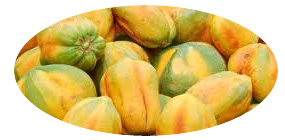Papaya is a tropical fruit widely consumed across the world with growing popularity over the past few years.
It is native to southern Mexico and Central America, but has long been known and cultivated in the home gardens by the people of tropical and subtropical areas. It is one of the few crops which fruit throughout the year, offering quick returns.
Over time, it has grown from the status of a home-garden crop to that of a commercial crop in many tropical countries as it is one of the highest producers of fruits by per-hectare.
Area and output
Over the last two decades global papaya production has more than tripled to 105 lakh tonnes in 2009 from 31 lakh tonnes in 1989. This growth in production has been accompanied by an increase in productivity to 25 tonnes a hectare from 14 tonnes a hectare. India is the leading producer of the fruit and has increased its share in world production to 37 per cent in 2009 from 11 per cent in 1989.
Other major producers are Brazil, contributing 17.1 per cent (17.92 lakh tonnes) of world tonnage, followed by Indonesia at 7.3 per cent (7.66 lakh tonnes), Nigeria at 7.3 per cent (7.63 lakh tonnes) and Mexico at 6.7 per cent (7.07 lakh tonnes).
A growing population and increasing per-capita incomes have generated robust demand for fruits in India. Besides, there has been a growing trend towards healthier food consumption reflected in the growing interest in the nutritional aspects of tropical fruits.
This change is borne out by a multi-fold increase in production of papaya over the last two decades, primarily on domestic demand.
Between 1991-92 and 2009-10, the area under cultivation for papaya more than doubled to 95.7 thousand hectares from 45.2 thousand hectares in India, whereas production witnessed an almost five-fold increase to 39.14 lakh tonnes from 8.05 lakh tonnes. This was due to an increase in productivity to 41 tonnes a hectare in 2009-10 from 18 tonnes a hectare in 1991-92.
This compares well withto the world average of 25 tonnes a hectare but lags the other key producers like Brazil, Indonesia and Mexico.
Andhra Pradesh produces a significant proportion of the crop at around 38 per cent, with an output of 15 lakh tonnes and a yield of 80 tonnes a hectare.
Gujarat ranks second with a production of 8.32 lakh tonnes, followed by Karnataka (4.19 lakh tonnes), West Bengal (3.21 lakh tonnes), Chhattisgarh (2.12 lakh tonnes), Madhya Pradesh (1.93 lakh tonnes), Assam (1.19 lakh tonnes), Kerala (0.8 lakh tonnes) and Tamil Nadu (0.74 lakh tonnes). Of these, the top four accounted for 79 per cent of the total production in 2009-10.
Global Trade
In 2008, global exports of papaya were 2,45,937 tonnes and worth about Rs 940 crore. Mexico is the largest exporter of papaya by volume accounting for 37 per cent of the exports, followed by Brazil and Belize at 12 per cent.
The US accounts for over 50 per cent of papaya imports by volume and over 30 per cent by value. Other key importers are Singapore, Canada, the Netherlands, Germany, the UK, Spain and Portugal.
India exports less than 1 per cent of its produce primarily to West Asia. This accounts for 3-6 per cent by volume and a miniscule 1-2 per cent by value of global papaya exports.
The ripe fruit is eaten raw or processed into juices, jams, canned cubes, candied slices, ice-cream flavouring, etc. The unripe fruit is usually cooked before consuming.
Green papaya fruit and the tree’s latex are rich in an enzyme called papain, which has uses in medicine and industry. Papain is used as a protein digestive and in the manufacture of pharmaceutical preparations for digestive disorders.
It finds extensive use in the manufacture of proteolysed preparations of meat, liver and casein. It is also used in tenderising meat, softening leathers, degumming natural silk and wool fabrics, chewing gums, tooth paste and cosmetics.
Post-harvest
Papaya is highly perishable with a shelf-life of four to six days after harvest under tropical conditions and up to three weeks at low-temperature storage. Post-harvest losses can be significant if harvesting, packing and handling techniques are inadequate or inappropriate.
Moreover, sellers require the fruit at specific stages of ripeness for optimum sales, which is around 50-70 per cent of yellow colouring. Therefore, for the fruit to arrive in markets properly ripened, attention has to be paid when packed, with adequate time buffer built in for transport.
Productivity has been lower in India as compared to most major producing countries due to cultivation of local low-yield varieties. Additionally, papaya is highly susceptible to pests and diseases, which further lower productivity. On the other hand, lack of information on post-harvest handling, storage and transport practices leads to losses.
Way Forward
Demand for papaya in the domestic as well as export markets and its profitability for farmers requires a deeper look at all opportunities for its commercial exploitation.
The Government and the private sector must work towards introduction of higher yielding varieties and focus on infrastructure, transport and human-resource development to minimise pre- and post-harvest losses. Papaya is still primarily consumed raw.
Developing more processing options and markets for processed products can reduce post-harvest losses, besides adding value to the produce.
Source: YES Bank

